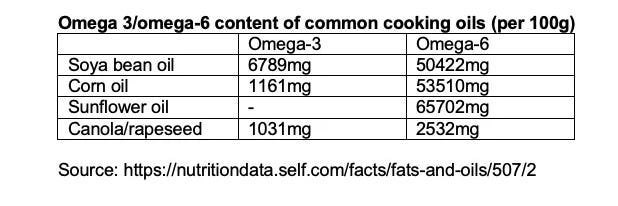It’s not unusual for food packaging to boast that the product it contains is ‘high in polyunsaturates.’ This statement is intended as a declaration of the nutritional virtues of that product. It is consistent with government guidelines that validate polyunsaturates as the ‘good’ fats, as opposed to the ‘bad’ saturated fats.
It’s nice to have complex issues simplified. But this issue isn’t simple. And polyunsaturates are not necessarily good.
I’m not saying polyunsaturated fats should be avoided. Au contraire: they are essential. Let me explain this confusing and apparent contradiction.
There are two classes of polyunsaturated fatty acids (PUFAs): omega-6 and omega-3. A PUFA is a chain of carbon atoms with two or more double bonds. Because they are not saturated (with hydrogen) they are liquid rather than solid at room temperature. Think cooking oil.
Why you need both
Both classes are functionally distinct, and one cannot substitute the other. Although the body can make some PUFAs, its capacity to do so is extremely limited. In reality, you need to get them both from your diet to avoid deficiency.
Omega-6 PUFAs are an essential component of each cell membrane and are involved in brain, reproductive, metabolic, immune and bone health. Symptoms of deficiency include dry skin, headache, joint problems, poor hair quality, and excessive thirst.
The main dietary source is cooking oils: corn, sunflower, soya bean oil, safflower. Margarines and spreads are full of omega-6.
Omega-3 PUFAs are also part of each cell membrane and are especially important for brain, cardiovascular, endocrine and musculoskeletal health.
Deficiency symptoms include dry eyes, dry skin, joint pain, brain fog, poor memory. The richest source of omega-3 PUFAs are oily fish, and fish and krill oil supplements.
So far, so straightforward.
It’s all about the ratio
These fats may be essential, but when the ratio between them is skewed, so too is health. You need both classes in the right amounts.
Although the ideal ratio of omega-6 to omega-3 has never been officially established, it is generally agreed that it should be in the region of 1-2:1. This was the ratio that was the norm during the Palaeolithic period, before the advent of agriculture, and that is believed to be ‘a perfect and balanced ratio’. Animals in the wild tend to consume the diet to which they are genetically adapted, and humans are no exception.
The human diet changed enormously after we transitioned from hunter-gathering to agriculture, and grains like wheat, corn, rice, etc became the basis of our diets. There was a second seismic shift following the Industrial Revolution, a period of transformation that led to urbanisation and a move away from self-sufficiency.
It also led to some highly regrettable dietary mutations. In 1911 Proctor & Gamble launched a hydrogenated cottonseed shortening called Crisco. The cooking oil industry was born, and it changed the course of human health.
This diet reorientation, incorporating novel ingredients, has been described as ‘a total new phenomenon in human evolution.’ Suddenly, we were consuming vastly more omega-6 than omega-3.
In the past three decades, total and saturated fat intake has decreased significantly, but intake of omega-6 PUFAs has skyrocketed. We now consume these oils in a ratio of 20-50:1.
‘This change in the n-6/n-3 ratio, possibly more than any other dietary factor, has contributed to the significant increase in the prevalence of body tissue and systemic inflammation and overweight/obesity which altogether leads to an epidemic of other diet-related chronic noncommunicable diseases such as coronary heart disease, hypertension, cancer, type 2 diabetes, arthritis, and other autoimmune and possibly neurodegenerative diseases’
It is not easy to recalibrate the scales. It certainly doesn’t help that both classes of PUFA compete for uptake in the body; too much of one will muscle out the other. The omega-3s don’t stand much chance, when faced with an avalanche of omega-6. That means that anyone consuming a typical Western diet is probably omega-3 deficient.
The effect of the skewed ratio
Both omega-6 and omega-3 PUFAs are metabolised in the body to hormone-like substances called eicosanoids. Overall, omega-6 eicosanoids are pro-inflammatory and omega-3 eicosanoids are anti-inflammatory.
Inflammation is a crucial component of the immune system’s infection-fighting mechanism. But prolonged and uncontrolled inflammation is a significant threat to health and is believed to underpin most chronic conditions in the industrialised world: cardiovascular disease, obesity, cancer, type 2 diabetes and Alzheimer’s. Incidence of all these conditions continue to rise across the globe.
Chronic, low-grade inflammation in the brain is a factor in the development of many neurodegenerative and psychiatric diseases, including dementia and depression. It is also seen in Parkinson’s disease, multiple sclerosis, and Huntington’s disease.
The UK Biobank is a database holding genetic, biological, medical and health information on half a million people aged between 40 and 69. This information is taken from blood, urine and saliva samples. The project has been ongoing since 2006.
Many countries have a biobank, including the US, Canada, Spain, and Brazil. It’s an extremely useful resource for researchers.
In this instance, scientists examined plasma omega-3 and omega-6 PUFAs and their relationship with risk of mortality. More than 85,000 participants were involved, and they were tracked for an average of 13 years.
What the researchers discovered was that risk of death from cancer and cardiovascular disease increased as the ratio of omega-6/omega-3 PUFAs rose in parallel.
Those with the highest ratio of omega-6 to omega-3 fatty acids had the highest mortality rates. They had a 31% higher rate of death from cardioavascular disease, and a 14% higher cancer mortality rate, than those with the lowest ratio.
Change the ratio
To lower your chances of developing chronic, common diseases, lower your ratio of omega-6 to omega-3.
A ratio of 4:1 has been associated with a 70% decrease in total mortality from coronary heart disease. The lower the better, it would seem.
‘..both the ancient and modern hunter-gatherers following Paleolithic diets with an n-6/n-3 ratio of 1-2/1 were free of modern inflammatory diseases, like heart diseases, cancer, and diabetes, in which they are the primary cause of death and morbidity today’
Here are four ways to tip the balance in the right direction.
Stop cooking your food with seed oils, such as sunflower, corn, and soya. Aside from the omega-6 content, the refining process that these oils undergo is diabolical and creates vast amounts of oxidising free radicals. That’s a whole different horror story.
Instead cook with butter, lard, tallow, coconut oil or extra virgin olive oil.
Avoid processed foods that contain these seed oils. A lot of them do.
Increase your intake of omega-3-rich foods. Oily fish (and shellfish) are the richest sources. Oily fish include mackerel, salmon, sardines, herring, anchovies. The next best source is grass-fed meat and free-range eggs. Animals fed grains instead of grass tend to produce meat (and eggs) with a higher omega-6 content. Farmed salmon contains much less omega-3 than wild salmon.
Get all the omega-6 you need from meat, leafy green vegetables and an occasional handful of your favourite, unroasted nuts. Brazils, almonds, hazelnuts, walnuts, peanuts, pecans and cashews are all naturally high in omega-6 PUFAs.
Modern agricultural systems are fixated on food production and security, and they are killing us. The focus on grains and seed oils means that inflammation and all its consequences are universal.
Level out the PUFA ratio of your diet and regard boastful declarations about polyunsaturates on labels as a warning, rather than an endorsement.







If it’s got a claim on the label about polyunsaturates, it is not real food. It is an FLS (food-like substance).
My favoite part of this post:
"Stop cooking your food with seed oils, such as sunflower, corn, and soya. Aside from the omega-6 content, the refining process that these oils undergo is diabolical and creates vast amounts of oxidising free radicals."
Diabolical! I agree